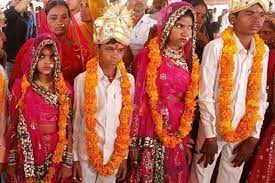Naima Akram
“In India, an analysis of child marriage data shows that among girls married before 18, 46 percent were also from the lowest income bracket,” claims a report published in 2020. The sickening mindset of boys being assets and girls being a burden often contributes to mishaps in the life of a girl child. Despite having several dreams and desires, girls are coerced into child marriage, increasing the gender gap in the country.
Mansa Bi, a resident of Mandi Tehsil in Poonch, Jammu and Kashmir, got her elder daughter married at the age of 16. After losing her husband, who earned for the family, she had two options: either get their three daughters married as soon as possible to reduce the financial crisis or suffer the crisis together. “I had to get one of my daughters married early after class 7 as I couldn’t afford her education. It was difficult for me to manage my own house. I have a son, but he doesn’t live with me.” Families in poverty frequently believe that marrying off their daughters will provide them with a better life.The concept of educating daughters and empowering them financially to look after themselves goes against the gender roles they have attributed to a girl and women in the society. As an ‘ideal’ daughter, the girl child gives into the forced marriages considering the financial condition.
“My marriage was forced, but I am happy now. I live with my mother-in-law and my husband. I did not have any big dreams before marriage, but I wanted to study. My father passed away when I was a child and my sisters and mother were in my house. Who would teach us after my father passed away? Studying requires money. And we are poor,” expressed SaleemaAkhtar, the elder daughter of Mansa Bi.
Following the elder daughter’s marriage, Mansa was about to get her second daughter married after arranging her engagement to a 35-year-old man. Later, Mansa was informed that the man had been married twice and had been divorced, which made her call off the engagement. She had paid Rs 130,000 to break the engagement with the man, some of which had been borrowed from a bank and the rest as personal loans. “After this incident, I don’t want to get my daughter married so early. But my neighbours are already after me to get my second daughter hitched,” shared Mansa.
Looking at the increasing number of child marriages in the Union Territory, the Jammu and Kashmir government has also drafted an act for the prohibition of child marriage.
According to a report, and an order from the Social Welfare Department, the act will be known as the “Jammu and Kashmir Prohibition of Child Marriage Rules, 2023” under The Prohibition of Child Marriage Act, 2006 (Centre Act 6 of 2007). Under the act, Child Marriage Protection Officers (CMPO) will be appointed and people who inform about child marriage will be suitably rewarded.
While the national average of girl child marriages has come down in recent years, Jammu and Kashmir, on the other hand, showed a significant increase of 0.9 percent from 2012 until 2020. Although, the local administrations are taking necessary measures to eliminate child marriage, it is important to take interventions at different levels. First, to aware the communities about the disadvantages of child marriage.
However, awareness alone will not bring desired changes, unless the roles of girls and women are not restricted to taking care of families and maintaining the “honour” of the family. Most importantly, take additional or region-specific measures, keeping in mind the Union Territory’s political disputes, which affect women and girls, making them doubly oppressed.
(The writer is a student of class 12 from Poonch, Jammu and Kashmir.)
Charkha Features
Trending Now
E-Paper


